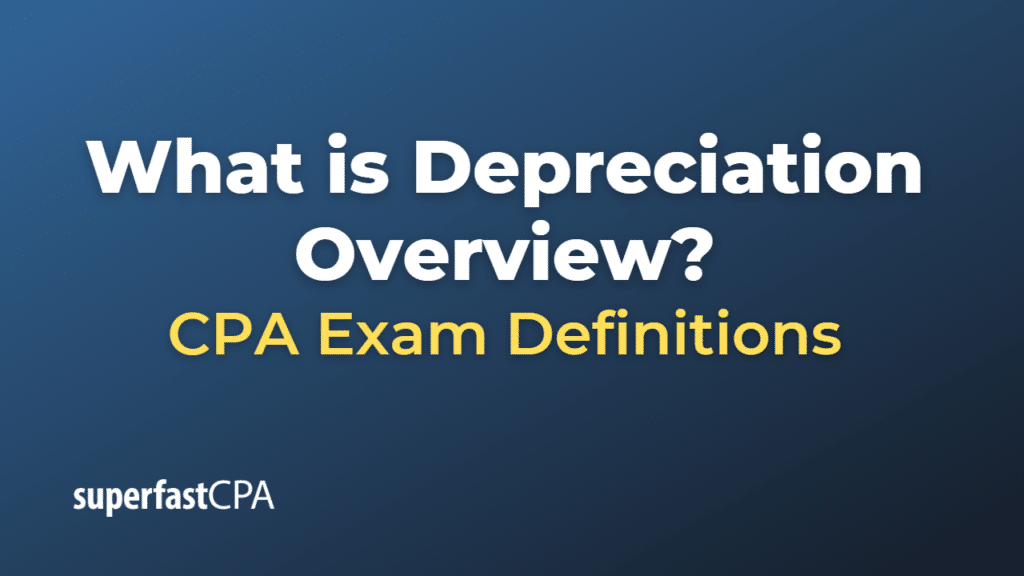Depreciation Overview
Depreciation is an accounting process that allows businesses to allocate the cost of long-term assets over their useful lives. These assets could include buildings, machinery, equipment, vehicles, and more. The idea behind depreciation is to match the expense of acquiring the asset with the revenue it generates over its productive life, in accordance with the matching principle of accounting.
Here’s a general overview of how depreciation works:
- Asset Purchase: When a business purchases a long-term or fixed asset that will benefit the business for more than one year, it records the cost of that asset as a capital expenditure, which appears as an asset on the balance sheet.
- Asset Utilization: Over time, as the asset is used to generate revenue, it gradually loses value due to factors like wear and tear, obsolescence, or legal limits on its use. This loss in value is recognized as depreciation.
- Depreciation expense: Depreciation expense is the portion of the asset’s cost that is transferred from the balance sheet to the income statement during each accounting period. This expense reduces the company’s net income for the period.
- Accumulated Depreciation: Accumulated depreciation is the total depreciation that has been recognized on an asset since its acquisition. It is a contra-asset account, meaning it is subtracted from the asset’s cost on the balance sheet to give the asset’s net book value.
- Depreciation Methods: There are various methods for calculating depreciation, including straight-line (where the asset loses the same amount of value each year), declining balance (where it loses a larger portion of its value in the early years), and units of production (where depreciation is based on usage or output).
- Impact on Cash Flows: It’s important to note that depreciation is a non-cash expense. Even though it reduces net income on the income statement, it doesn’t involve an actual outflow of cash. However, because it is a tax-deductible expense, it can reduce a company’s tax liability and thus positively affect cash flows.
Depreciation is an essential concept in accounting and finance. It allows companies to better match their income with their expenses, gives a more accurate picture of an asset’s value over time, and can affect cash flows and taxes.
Example of Depreciation Overview
Let’s illustrate the concept of depreciation with a practical example:
Suppose that a bakery buys an oven for $10,000. The oven is expected to have a useful life of 10 years, and after those 10 years, it’s expected to have a salvage value (residual value) of $1,000. The bakery uses the straight-line method of depreciation, which is the most common method and simply allocates the depreciable amount evenly over the asset’s useful life.
- Asset Purchase: The bakery records the oven as a fixed asset on the balance sheet at its acquisition cost of $10,000.
- Depreciable Base: The depreciable base is the total amount that will be depreciated over the asset’s life. In this case, it’s the cost of the oven minus its expected salvage value, or $10,000 – $1,000 = $9,000.
- Annual Depreciation Expense: With the straight-line method, the annual depreciation expense is the depreciable base divided by the asset’s useful life. Here, that’s $9,000 / 10 years = $900 per year.
- Recording Depreciation: Each year, the bakery will record a depreciation expense of $900 on the income statement, which reduces its net income for that year. It also records $900 in the accumulated depreciation account on the balance sheet.
- net book value: The net book value of the oven on the balance sheet is its original cost minus the accumulated depreciation. After the first year, the net book value will be $10,000 – $900 = $9,100. After the second year, it will be $10,000 – $1,800 = $8,200, and so on.
- End of Useful Life : At the end of the oven’s 10-year life, its accumulated depreciation will equal the depreciable base of $9,000, and its net book value will be its salvage value of $1,000.
Remember, the depreciation expense is a non-cash charge; it doesn’t reduce the bakery’s cash balance. However, it does reduce the bakery’s taxable income, and therefore its tax expense, which indirectly benefits its cash flow.













